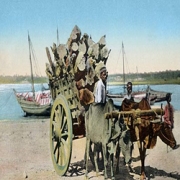Ancient India Economy in Indus Valley Civilization
Since Indus valley civilization was of Bronze Age and its economy was more urban based whereas the Vedic civilization is marked by Iron Age its economy was related more to the agricultural mode of production.
The terracotta figurines of boats and bullock driven carts suggest their use in propagating the Indus valley economy. Many of the figurines of the boats are small, flat-bottomed craft, perhaps driven by sail. There is also some evidence of large sea-going craft. The figure of bullock-driven cart points to its use in the inland tradeas a mode of transportation.
The dispersal of the artifacts of the Indus civilization suggest the trade networks, economically, integrated a huge area, including portions of Afghanistan, the coastal regions of Persia, northern and central India, and Mesopotamia.
The people of Indus valley civilization traded with Sumer and Sumerian merchants referred them as Meluhha. They also traded with Mesopotamia and Egypt. They sent merchant ships to the island of Tilmun in the Persian Gulf.

Bullock-driven cartsThe main items of exports included surplus grain, pottery vases, inlays, ivory combs, pearls, precious woods, and semi-precious stones. Indus Valley farmers grew wheat, barley, field-peas, melons, sesame, and dates. They also domesticated humped cattle, short-horn cattle, and buffaloes, and perhaps even pigs, camels, horses, and donkeys. The land was full of water buffalo, tigers, elephants, rhinoceros and enormous forests.
Cotton was first developed around 2000 B.C. and Indus valley people were the first to turn cotton into yarn and weaving the yarn into cloth. The lack of public inscriptions or written historical documents has hindered more information about the economy of the Indus valley civilization. The unique Indus script consisting of 400 symbolic pictures is not yet deciphered.


0 Comments:
Post a Comment